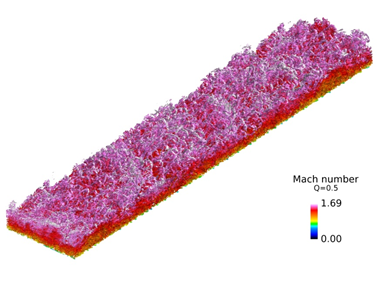Research for maintenance and enhancement of aerospace technology
JAXA Supercomputer System Annual Report April 2016-March 2017
Report Number: R16E0077
- Responsible Representative: Takumi Ujino(Technical Counselor)
- Contact Information: Takanori Haga(haga.takanori@jaxa.jp)
- Members: Seiji Tsutsumi, Hiroyuki Ito, Masaharu Abe, Takanori Haga
- Subject Category: Basic Research(Modeling,CFD)
Abstract
Prediction accuracy of turbulent flows in high Reynolds number is important for aerospace fluid problems. The conventional RANS model is not sufficient for accurately predicting separation and reattachment of the boundary layer and its transition. On the other hand, the computational cost of LES which resolves to small scale vortices near the wall is prohibitively expensive. We focus on improving the prediction accuracy of high Reynolds number wall turbulence flow with feasible computational cost aiming for extending applicability of CFD as a design tool.
Goal
By strengthening fundamental analysis methods and developing advanced analysis methods for aerospace simulations, we acquire a numerical analysis technology that can contribute to more reliable and efficient design and development, and will lead to future JAXA’s projects.
Objective
Develop a new numerical analysis technology that is more reliable and more efficient than the conventional approach and that is also applicable to problems that are difficult to analyze by the conventional methods.
References and Links
N/A
Use of the Supercomputer
Perform tens of millions scale LES of the turbulent boundary layer and its post processing.
Necessity of the Supercomputer
In order to resolve the multiscale vortex of high Reynolds number wall turbulence it is necessary to have supercomputing resources.
Achievements of the Year
Wall modeled LES (WM-LES) of the supersonic flat plate boundary layer was performed by using the wall stress model which can greatly alleviate the computational cost of high Reynolds number wall turbulence. In WM-LES, the inner layer region (less than about 10% of the boundary layer thickness δ) where the scale effect of Reynolds number appears is modeled, so that we can significantly reduce the computational cost of the inner layer, which is dominant in the high Reynolds number flow. In this study, the wall stress model was extended for the LES solver based on the Flux Reconstruction (FR) method which can utilize unstructured grids.
Fig. 1 shows the computational results. Freestream Mach number is 1.69, Reynolds number is Reδ=6.1×105(Reθ=5×104). The height of the wall-layer for inputting the LES result was fixed at hwm=0.055δ. The grid cell size is Δyw=0.66hwm, Δx=Δz=0.084δ and in the wall unit, Δx+=Δz+≈880,hwm+≈1180, hence the grid spacing is much coarser than in traditional wall-resolved LES. In the FR method, it has degrees of freedom in each cell, and therefore the grid spacing should be considered to be about a quarter (p3, 4th-order scheme). The number of computational points (the total number of degrees of freedom) is about 40 million. For the future work, we will compare the turbulence statistics data with the literature value and investigate the minimum grid resolution required by the proposed method, and proceed with adaptation to real problems.
Publications
Will be presented at academic conference and published on a journal paper.
Computational Information
- Parallelization Methods: Hybrid Parallelization
- Process Parallelization Methods: MPI
- Thread Parallelization Methods: OpenMP
- Number of Processes: 32
- Number of Threads per Process: 8
- Number of Nodes Used: 8
- Elapsed Time per Case (Hours): 280
- Number of Cases: 10
Resources Used
Total Amount of Virtual Cost(Yen): 5,303,437
Breakdown List by Resources
| System Name | Amount of Core Time(core x hours) | Virtual Cost(Yen) |
|---|---|---|
| SORA-MA | 2,136,851.12 | 3,448,180 |
| SORA-PP | 101,860.38 | 869,683 |
| SORA-LM | 20,340.35 | 457,657 |
| SORA-TPP | 0.00 | 0 |
| File System Name | Storage assigned(GiB) | Virtual Cost(Yen) |
|---|---|---|
| /home | 7,270.69 | 68,584 |
| /data | 29,502.97 | 278,302 |
| /ltmp | 833.31 | 7,860 |
| Archiving System Name | Storage used(TiB) | Virtual Cost(Yen) |
|---|---|---|
| J-SPACE | 56.09 | 173,166 |
Note: Virtual Cost=amount of cost, using the unit price list of JAXA Facility Utilization program(2016)
JAXA Supercomputer System Annual Report April 2016-March 2017



